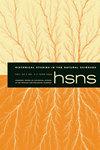从种族类型到土著血统
IF 0.3
3区 哲学
Q2 HISTORY & PHILOSOPHY OF SCIENCE
引用次数: 2
摘要
20世纪中期,约瑟夫·b·伯德塞尔(Joseph B. Birdsell)在澳大利亚的田野调查,或许是独一无二的,说明了从第二次世界大战前体质人类学的类型学结构,到人类生物学对基因的地理或临床模式越来越感兴趣,以及对漂变和选择概念的承诺的转变。它还表明,一些形态学研究一直延续到战后时期,对种族迁移和杂交理论的依恋也是如此。伯德塞尔在澳大利亚土著人中进行了密集而长期的田野调查,最终使他对移民殖民主义和白人种族主义提出了批评,正是这些殖民主义和种族主义使他的探险和数据收集成为可能。然而,他继续将土著社区视为“岛屿实验室”,并将土著居民视为方便的研究对象,使自己与他们的生活世界以及被剥夺和剥削的经历保持距离。这篇文章是沃里克·安德森和M.苏珊·林迪编辑的题为《太平洋生物学:人类是如何遗传的》特刊的一部分。本文章由计算机程序翻译,如有差异,请以英文原文为准。
From Racial Types to Aboriginal Clines
The mid-twentieth century Australian fieldwork of Joseph B. Birdsell illustrates, perhaps uniquely, the transition from typological structuring in physical anthropology before World War II to human biology’s increasing interest in the geographical or clinal patterning of genes and commitment to notions of drift and selection. It also shows that some morphological inquiries lingered into the postwar period, as did an attachment to theories of racial migration and hybridization. Birdsell’s intensive and long-term fieldwork among Aboriginal Australians eventually led him to criticize the settler colonialism and white racism that had made possible his expeditions and data collection. Yet he continued to regard Aboriginal communities as “island laboratories” and to treat Aboriginal people as convenient research subjects, distancing himself from their life worlds and experiences of dispossession and exploitation.
This essay is part of a special issue entitled Pacific Biologies: How Humans Become Genetic, edited by Warwick Anderson and M. Susan Lindee.
求助全文
通过发布文献求助,成功后即可免费获取论文全文。
去求助
来源期刊

Historical Studies in the Natural Sciences
社会科学-科学史与科学哲学
CiteScore
1.00
自引率
0.00%
发文量
24
审稿时长
>12 weeks
期刊介绍:
Explore the fascinating world of Historical Studies in the Natural Sciences, a journal that reveals the history of science as it has developed since the 18th century. HSNS offers in-depth articles on a wide range of scientific fields, their social and cultural histories and supporting institutions, including astronomy, geology, physics, genetics, natural history, chemistry, meteorology, and molecular biology. Widely regarded as a leading journal in the historiography of science and technology, HSNS increased its publication to five times per year in 2012 to expand its roster of pioneering articles and notable reviews by the most influential writers in the field.
 求助内容:
求助内容: 应助结果提醒方式:
应助结果提醒方式:


